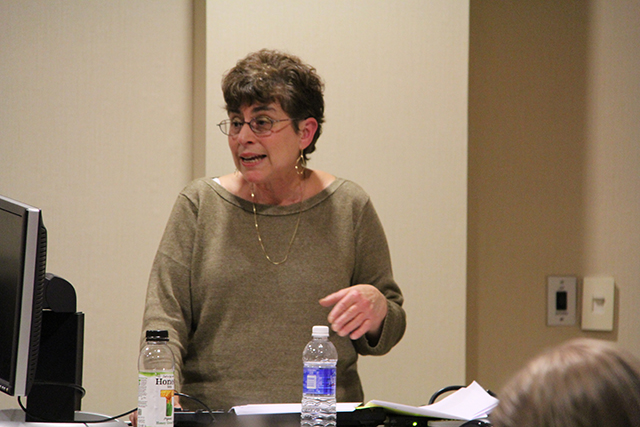
Photo by Giancarlo Sepulveda
On Tuesday, Dr. Vicki Caron, a prestigious scholar, author and professor emeritus of modern Jewish history and Jewish studies at Cornell University, gave a lecture on Catholic anti-Semitism in France during the late 19 century. The audience was mainly comprised of students from history professor Michael Riff’s Paradigms of Genocide class. This topic of Catholic-Jewish relations during this time period in France is also the topic of Caron’s upcoming book, “The Battle for the Republic: Jews and Catholics in fin-de-siecle France. 1870-1914,” which the Harvard University Press will publish in 2018.
Caron is also the author of “Uneasy Asylum, France and the Jewish Refugee Crisis, 1933-1942,” which won the Fraenkel Prize in 1997, and many other scholarly writings. Her lecture in Alumni Lounge SC-156 aimed to inform students about the connection between “traditional” religious anti-Semitism and “modern” racial anti-Semitism, the connection between anti-Semitism and the “anti-clerical” movement in France, and the connection between this early incitement of modern anti-Semitism and the Holocaust.
“In examining the history of anti-Semitism in Europe … It’s really become commonplace among historians to distinguish between modern anti-Semitism, which most historians date at the end of the 19th century … and traditional religious anti-Semitism, which some scholars would call anti-Judaism,” Caron said, disagreeing that these two eras of anti-Semitism are completely separate, for reasons she later demonstrated with her explanation of the anti-Semitism, which rose out of the anti-clericalism in France between 1870 and the 1910s, especially with the publication of Édouard Drumont’s extremely anti-Semitic book “La France Juive” – or “Jewish France” – in 1886.
Anti-clericalism refers to the ideology that religion should be separated from the government, and at that time in France, this movement sought to remove Catholicism from public institutions. Catholics who were opposed to this removal blamed Jews for being anti-Catholic, despite the fact that many people of different religions were actually behind the movement.
“It didn’t take long for Catholics to respond to this anti-clerical campaign,” Caron said. “In response to this assault they blasted Republicans, whom they identified first with the freemasons, but also increasingly with Jews, claiming that they were out to dismantle the Christian state and even also more specifically the Catholic church.”
From this era of reactionary anti-Semitism came many anti-Jewish demonstrations and boycotts in France and several violently anti-Semitic writings in addition to Drumont’s “Jewish France.” These writings often had consistent themes, Caron explained, saying that the texts “called for restoring all the medieval restrictions on Jews – banning them from holding public office, stripping them of citizenship, sometimes even relegating them to ghettoes … some of these individuals even called for bringing back the distinctive clothing Jews were to wear.” These views would later be paralleled by the treatment of Jews by Nazis during the Holocaust.
Caron gave many examples throughout her presentation about how anti-Semitism began to have racial undertones during this time, including the fact that Drumont, whose writings and ideas were extremely influential during the time, “did embrace racial terminology both in that book … as well as in the newspaper he published called ‘La Libre Parole’.” In tying this racial and religious hatred to the Holocaust, Caron described how it was easy for the German people to accept Hitler’s racial ideologies when their religious ideologies already lined up with the idea that Jews were inferior and evil.
“Words are the power behind a movement,” commented senior biology and international studies double major Japhia Steele, during the Q&A segment of the lecture when the discussion had turned to the topic of rhetoric leading to action. “If you’re spewing out hateful words that can definitely stem off into acts of violence.”
Riff, who brought his class to the lecture, added that “in every case of genocide, there is a period of incitement before.” However, he also said this: “One thing I always emphasize to students is that this process doesn’t necessarily have to end in genocide – it can end in something equally insidious in a way … The process is not automatic.”
lfrench@ramapo.edu





